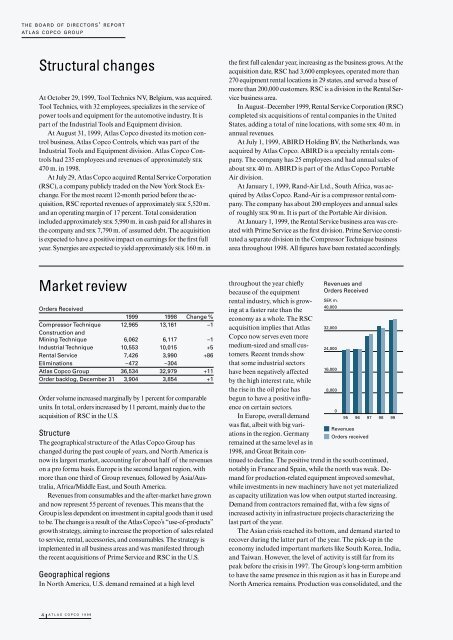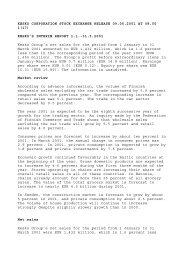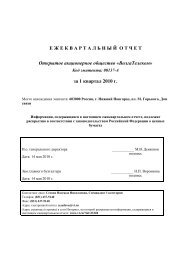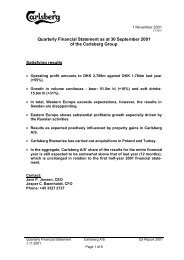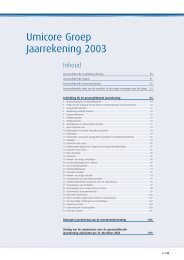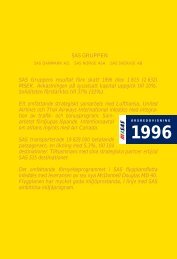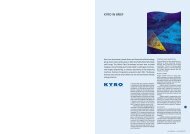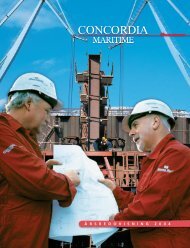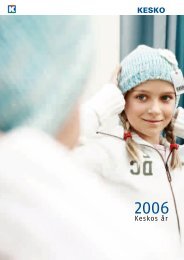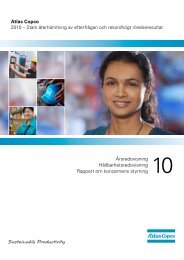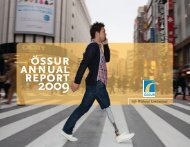Atlas Copco - Annual Report 1999
Atlas Copco - Annual Report 1999
Atlas Copco - Annual Report 1999
You also want an ePaper? Increase the reach of your titles
YUMPU automatically turns print PDFs into web optimized ePapers that Google loves.
THE BOARD OF DIRECTORS’ REPORT<br />
ATLAS COPCO GROUP<br />
Structural changes<br />
At October 29, <strong>1999</strong>, Tool Technics NV, Belgium, was acquired.<br />
Tool Technics, with 32 employees, specializes in the service of<br />
power tools and equipment for the automotive industry. It is<br />
part of the Industrial Tools and Equipment division.<br />
At August 31, <strong>1999</strong>, <strong>Atlas</strong> <strong>Copco</strong> divested its motion control<br />
business, <strong>Atlas</strong> <strong>Copco</strong> Controls, which was part of the<br />
Industrial Tools and Equipment division. <strong>Atlas</strong> <strong>Copco</strong> Controls<br />
had 235 employees and revenues of approximately SEK<br />
470 m. in 1998.<br />
At July 29, <strong>Atlas</strong> <strong>Copco</strong> acquired Rental Service Corporation<br />
(RSC), a company publicly traded on the New York Stock Exchange.<br />
For the most recent 12-month period before the acquisition,<br />
RSC reported revenues of approximately SEK 5,520 m.<br />
and an operating margin of 17 percent. Total consideration<br />
included approximately SEK 5,990 m. in cash paid for all shares in<br />
the company and SEK 7,790 m. of assumed debt. The acquisition<br />
is expected to have a positive impact on earnings for the first full<br />
year. Synergies are expected to yield approximately SEK 160 m. in<br />
Market review<br />
Orders Received<br />
<strong>1999</strong> 1998 Change %<br />
Compressor Technique<br />
Construction and<br />
12,965 13,161 –1<br />
Mining Technique 6,062 6,117 –1<br />
Industrial Technique 10,553 10,015 +5<br />
Rental Service 7,426 3,990 +86<br />
Eliminations –472 –304<br />
<strong>Atlas</strong> <strong>Copco</strong> Group 36,534 32,979 +11<br />
Order backlog, December 31 3,904 3,854 +1<br />
Order volume increased marginally by 1 percent for comparable<br />
units. In total, orders increased by 11 percent, mainly due to the<br />
acquisition of RSC in the U.S.<br />
Structure<br />
The geographical structure of the <strong>Atlas</strong> <strong>Copco</strong> Group has<br />
changed during the past couple of years, and North America is<br />
now its largest market, accounting for about half of the revenues<br />
on a pro forma basis. Europe is the second largest region, with<br />
more than one third of Group revenues, followed by Asia/Australia,<br />
Africa/Middle East, and South America.<br />
Revenues from consumables and the after-market have grown<br />
and now represent 55 percent of revenues. This means that the<br />
Group is less dependent on investment in capital goods than it used<br />
to be. The change is a result of the <strong>Atlas</strong> <strong>Copco</strong>’s “use-of-products”<br />
growth strategy, aiming to increase the proportion of sales related<br />
to service, rental, accessories, and consumables. The strategy is<br />
implemented in all business areas and was manifested through<br />
the recent acquisitions of Prime Service and RSC in the U.S.<br />
Geographical regions<br />
In North America, U.S. demand remained at a high level<br />
4 ATLAS COPCO <strong>1999</strong><br />
the first full calendar year, increasing as the business grows. At the<br />
acquisition date, RSC had 3,600 employees, operated more than<br />
270 equipment rental locations in 29 states, and served a base of<br />
more than 200,000 customers. RSC is a division in the Rental Service<br />
business area.<br />
In August–December <strong>1999</strong>, Rental Service Corporation (RSC)<br />
completed six acquisitions of rental companies in the United<br />
States, adding a total of nine locations, with some SEK 40 m. in<br />
annual revenues.<br />
At July 1, <strong>1999</strong>, ABIRD Holding BV, the Netherlands, was<br />
acquired by <strong>Atlas</strong> <strong>Copco</strong>. ABIRD is a specialty rentals company.<br />
The company has 25 employees and had annual sales of<br />
about SEK 40 m. ABIRD is part of the <strong>Atlas</strong> <strong>Copco</strong> Portable<br />
Air division.<br />
At January 1, <strong>1999</strong>, Rand-Air Ltd., South Africa, was acquired<br />
by <strong>Atlas</strong> <strong>Copco</strong>. Rand-Air is a compressor rental company.<br />
The company has about 200 employees and annual sales<br />
of roughly SEK 90 m. It is part of the Portable Air division.<br />
At January 1, <strong>1999</strong>, the Rental Service business area was created<br />
with Prime Service as the first division. Prime Service constituted<br />
a separate division in the Compressor Technique business<br />
area throughout 1998. All figures have been restated accordingly.<br />
throughout the year chiefly<br />
because of the equipment<br />
rental industry, which is growing<br />
at a faster rate than the<br />
economy as a whole. The RSC<br />
acquisition implies that <strong>Atlas</strong><br />
<strong>Copco</strong> now serves even more<br />
medium-sized and small customers.<br />
Recent trends show<br />
that some industrial sectors<br />
have been negatively affected<br />
by the high interest rate, while<br />
the rise in the oil price has<br />
begun to have a positive influence<br />
on certain sectors.<br />
In Europe, overall demand<br />
was flat, albeit with big variations<br />
in the region. Germany<br />
remained at the same level as in<br />
1998, and Great Britain con-<br />
Revenues and<br />
Orders Received<br />
SEK m.<br />
40,000<br />
32,000<br />
24,000<br />
16,000<br />
8,000<br />
tinued to decline. The positive trend in the south continued,<br />
notably in France and Spain, while the north was weak. Demand<br />
for production-related equipment improved somewhat,<br />
while investments in new machinery have not yet materialized<br />
as capacity utilization was low when output started increasing.<br />
Demand from contractors remained flat, with a few signs of<br />
increased activity in infrastructure projects characterizing the<br />
last part of the year.<br />
The Asian crisis reached its bottom, and demand started to<br />
recover during the latter part of the year. The pick-up in the<br />
economy included important markets like South Korea, India,<br />
and Taiwan. However, the level of activity is still far from its<br />
peak before the crisis in 1997. The Group’s long-term ambition<br />
to have the same presence in this region as it has in Europe and<br />
North America remains. Production was consolidated, and the<br />
0<br />
95<br />
96<br />
97<br />
Revenues<br />
Orders received<br />
98<br />
99


